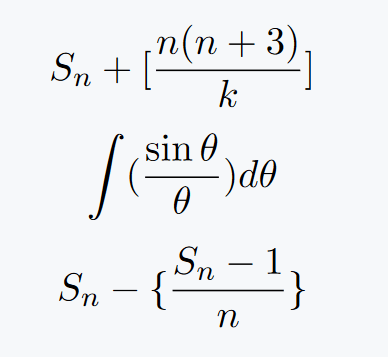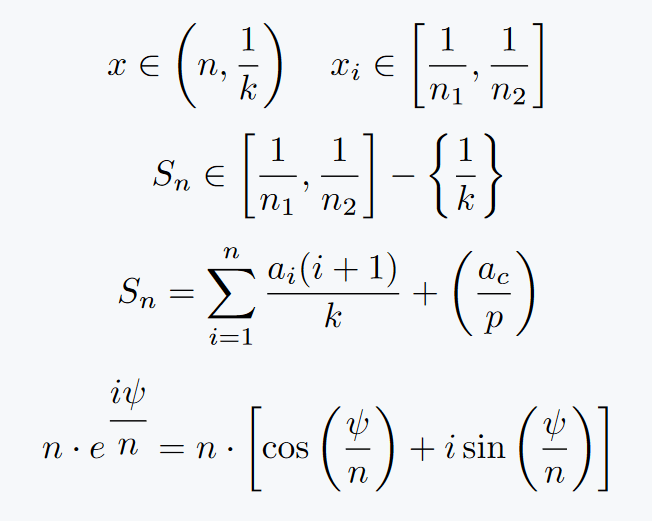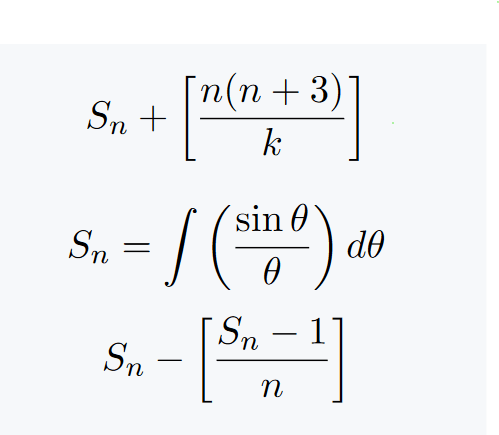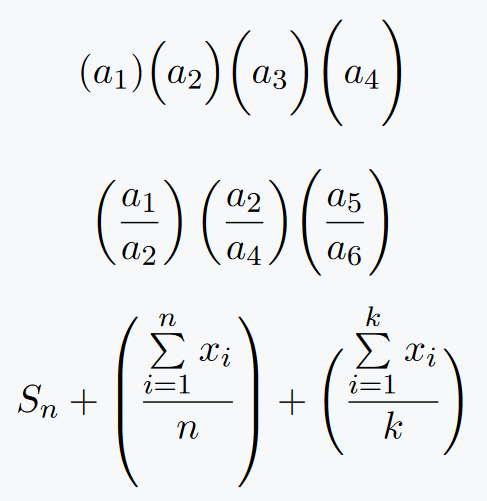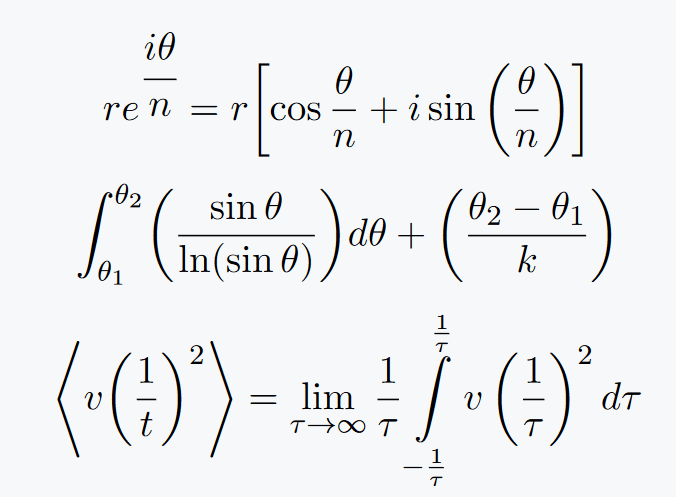In this tutorial, we will discuss the problems that we often face when we write equations in LaTeX. That is the parenthesis or bracket size problem in the equation.
Remember, when you are adding large-sized expressions to equations like summation, fractions, etc. In that case, the size of expression is much larger than the default brackets or parentheses. Consider the following problem.
\documentclass[11pt]{article}
\begin{document}
\[ S_n + [ \frac{n(n+3)}{k} ] \]
\[\int (\frac{\sin\theta}{\theta})d\theta \]
\[S_n -\{\frac{S_n -1}{n}\}\]
\end{document}Output :
This is a common problem that every beginner faces. But, after understanding this tutorial you don’t have to face any problem related to size of bracket or parenthesis.
Use of left and right commands
The most popular and usable solution is to use \left and \right commands.
Its usage is very simple like \left command before left bracket or parenthesis and \right command before right bracket or parenthesis.
\left( ... \right)
\left[ ... \right]
\left\{ ... \right\}
\left| ... \right|
\documentclass{article}
\usepackage{amsmath}
\begin{document}
\[ x\in \left(n,\frac{1}{k}\right) \quad x_i \in \left[ \frac{1}{n_1}, \frac{1}{n_2} \right] \]
\[ S_n\in \left[\frac{1}{n_1},\frac{1}{n_2}\right]-\left\{\frac{1}{k}\right\} \]
\[ S_n = \sum_{i=1}^{n}\frac{a_i(i+1)}{k} + \left(\frac{a_c}{p}\right) \]
\[n\cdot e^{\cfrac{i\psi}{n}} = n\cdot\left[\cos\left(\frac{\psi}{n}\right)+i\sin\left(\frac{\psi}{n}\right)\right] \]
\end{document}Output :
Short commands are created instead of left and right
I have used this technique in many tutorials before. Where large expressions are converted to short commands by newcommand.
\documentclass[11pt]{article}
\newcommand{\parx}[1]{\left(#1\right)}
\newcommand{\bracket}[1]{\left[#1\right]}
\begin{document}
\[ S_n + \bracket{\frac{n(n+3)}{k} } \]
\[ S_n = \int \parx{\frac{\sin\theta}{\theta}} d\theta \]
\[ S_n - \bracket{\frac{S_n -1}{n}} \]
\end{document}Output :
Using this short command once or twice will not take any effect.
Assume that you are creating a document where you repeatedly use large expressions. In that case, the use of short command will be effective.
You can add different styles if you want which is possible at once. No need to repeatedly edit the document.
Can I increase manually?
Yes, you can manually specify the size of brackets in LaTeX using the sizing commands. Here are the commonly used sizing commands.
\big : slightly larger than normal size.
\Big : larger than \big.
\bigg : even larger.
\Bigg : the largest.
\documentclass[11pt]{article}
\begin{document}
\[ \big(a_1\big) \Big(a_2\Big) \bigg(a_3\bigg) \Bigg(a_4\Bigg) \]
\[ \left(\frac{a_1}{a_2}\right) \bigg(\frac{a_2}{a_4}\bigg) \Bigg(\frac{a_5}{a_6}\Bigg)\]
\[ S_n + \left({\frac{\sum\limits_{i=1}^n x_i}{n}}\right) + \Bigg({\frac{\sum\limits_{i=1}^k x_i}{k}} \Bigg)\]
\end{document}Output :
Use physics package for equation
physics package in LaTeX provides shorthand notation for many common mathematical symbols, including various types of brackets and parentheses.
\documentclass[11pt]{article}
\usepackage{physics}
\begin{document}
\[ re^{\cfrac{i\theta}{n}} = r\qty[ \cos\frac{\theta}{n} +i\sin\qty(\frac{\theta}{n}) ] \]
\[\int_{\theta_1}^{\theta_2}\!\qty(\frac{\sin\theta}{\ln(\sin\theta)}){d\theta} + \left(\frac{\theta_2-\theta_1}{k}\right)\]
\[\left\langle v\qty(\frac{1}{t})^2 \right\rangle = \lim_{\tau \to \infty}\frac{1}{\tau} \int\limits_{-\frac{1}{\tau}}^{\frac{1}{\tau}} v\left(\frac{1}{\tau} \right)^2 {d\tau}\]
\end{document}Output :
In this example, \qty command from the physics package is used to represent parentheses and brackets responsively.
